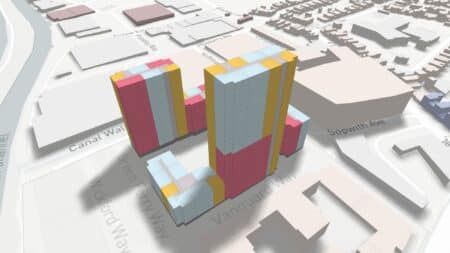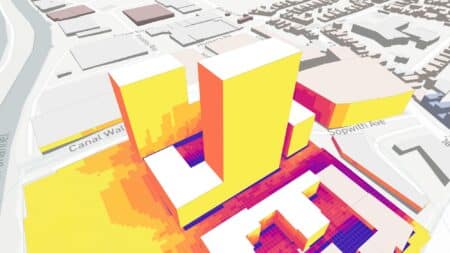Blue Ocean Sustainability, a lab-to-market software solutions provider, today officially unveiled its next-generation BIM solution. A two-tiered software application includes the Skema cloud-based 3D conceptual design tool for architects and designers and the Kreo Design platform for architecture firms.
Taken together, Blue Ocean Sustainability’s (BOS) software solution forms the AEC industry’s first BIM knowledge reuse engine.
Skema for Conceptual and Generative Design
Well officially released in this version today, Skema has already been in the hands of over 2,000 architects and engineers through the Spring 2023 Sustainability Challenge, a bite-sized learning series produced by the Green Building Education Services (GBES).

Skema allows architects to define massing options and can play with different unit mixes that best fit in a given massing model, which itself has been analyzed according to various criteria impacting the site.
These early-access users were able to see how Skema performs urban design, site assessment, and massing studies while also performing massing studies with comprehensive sustainability analysis. The software can generate multiple design options with different massing alternatives in one project.
“Designers need the ability to do analysis and iterate decisions in an agile and systematic way, and data-driven BIM 2.0 tools can help them improve their productivity,” said Martin (Marty) Rozmanith, Chief Technology Officer and Co-founder of Blue Ocean. “With the generative design capabilities of Skema, architects can conduct engineering simulations at the conceptual level and compare multiple options in a fluid manner. It helps them make more qualified decisions.”
Why Skema?
One key question is why Skema? What makes it unique? Skema takes data created in the conceptual stage and moves that data forward all the way through design development and into construction drawings. And the software company reports it does this in a way that works better for how architects actually work.
The unique features reported in Skema include:
- Create multiple uses/solves
- Proforma metrics analysis for building design at the site and building level
- Building layout concept catalogs can use a firm’s Revit data as inputs
- Produces blocking-stacking and Level of Development (LOD) 350 data and designs in Revit
- Methodology is extensible to all building types
- Output data fully editable in Revit for construction drawings
Many other minor features round out these salient characteristics. (More below).
Full Revit Integration
Many architecture firms have a significant investment in Revit. Blue Ocean is working with select design firms to deliver BIM LOD 350-as-a-service through the combination of Skema with the Kreo Design platform. These firms are partnering with Blue Ocean to transform their “file-based” processes to “data-driven” workflows, all while maintaining their sizable investment in Revit.
The integrated solution can automate 50+ percent of a floor plan layout, delivering the benefits of a data-driven workflow and the efficiency of automation. The solution uniquely delivers a higher LOD building that contains a firm’s own Revit families, types, and assemblies. Moreover, the integrated proforma metrics will help designers optimize the project based on owner requirements.
Decarbonization: Integrated Strategies
Charlie Cichetti, the co-founder of Blue Ocean, is utilizing his expertise in green building rating systems, energy modeling, and sustainability education to develop tools that significantly enhance project sustainability in response to the building industry’s need for decarbonization.
“Too often, sustainability goals are overlooked,” said Charlie Cichetti, CEO of Blue Ocean. “Blue Ocean aims to help designers improve a building’s carbon footprint, whether that’s at the schematic phase or in later stage design development, which previously would have been cost prohibitive. Because these advanced technologies and tools provide embodied & operational carbon feedback during each design phase, architects and designers can more easily incorporate sustainable elements in designs that meet their owner’s goals.”
Blue Ocean Founders
The founders of Blue Ocean, including Marty Rozmanith, Kristina Bach, and Charlie Cichetti, leverage their software, architecture, and green building expertise to provide solutions that assist architecture firms in redefining their business models and practices. Their collective experience encompasses the creation of Revit, LEED reviewing, and the establishment of multiple companies focused on sustainability in the built environment.
Blue Ocean partnered with Kreo Software, a London-based software development company, to bring Skema and Kreo Design to the market.
About Blue Ocean
Blue Ocean Sustainability partners with architects, designers, contractors, and building owners to develop lab-to-market solutions to radically improve project sustainability and future-enable their businesses. From tracking the full carbon footprint of a building to helping firms harvest their existing BIM knowledge, Blue Ocean is always thinking ahead to a more sustainable tomorrow. www.blueoceanaec.com
Architosh Commentary and Analysis
Blue Ocean, as a lab-to-market software company, has other solutions available to the market, including TrueCarbon, and, presently in the lab, DeWaterNYC. They are actively seeking partner architects, according to their website.
My friend and fellow AEC tech journalist Marty Day of AEC Magazine has called Blue Ocean “next-generation BIM.” Fundamentally, what Blue Ocean is announcing today are tools and solutions that fit what some like Day ever to as BIM 2.0. Blue Ocean co-founder Marty Rozmanith is one of the creators of Revit, while Bach and Cichetti have deep expertise in sustainability—Bach, a former USGBC reviewer, and Cichetti, a LEED Fellow.
What is interesting to see about this solution is the partial overlap with Autodesk Forma. Kreo’s concept of a “knowledge reuse engine” is a wonderful concept for the advancement of the field, especially considering the input value firms have devoted to solutions that have modularity in mind.




Reader Comments
Comments for this story are closed